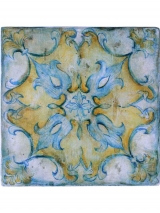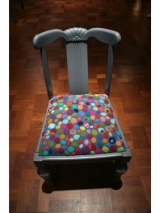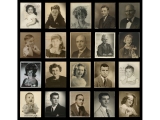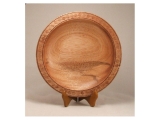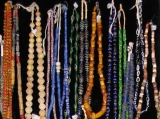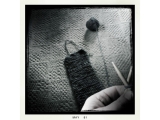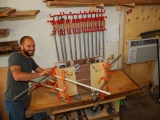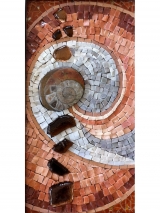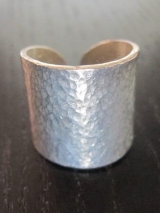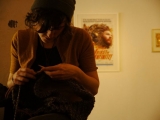Search
Guest Post
Guest Post
An art history scholar and painter, Jacqueline Moore found herself "anxious, afraid, stunted in creativity and at a crossroads" in 2009. The journey that began in England and had brought her to Southern California, led one afternoon to a garden in Montecito. She was strolling amidst lush plantings, breathing air fresh from a recent rain and captivated with what she considered "wee art works"- old hand painted tiles that dotted the landscape. Moore had an epiphany on that sunlit stroll.
Using her extensive knowledge of art history, design and architecture, her virtuoso skill with a brush, near forensic study ...
Guest Post
Bobby Silverman thought he wanted to be a social geographer, the study of spatial patterns, investigating how and why we live and work where we do. On the way to getting his degree, he took a detour to Japan. There he witnessed the daily use of beautiful handcrafted objects, born of traditions that were thousands of years old. He became an apprentice to the master potter Samejima Saturo. What might have felt serendipitous at the time was actually, according to Silverman "preordained." His family had actively collected antiques and decorative objects. The Japanese ritual of utilizing art that was functional ...
Guest Post
My earliest experiences in making things were not textiles at all. I was not brought up stitching with mum or Grandma, like so many textile makers. By contrast, I spent my pre-school years at home with my dad, mainly in the shed, making things out of wood. I had my own tiny workbench with saw, hammer, vice, and oil can (oh, how I loved my oil can!) and made things from balsa wood. The love of making things has never left me.
My dad later took me to costume museums, where I pressed my nose against the glass, absorbed every detail ...
Guest Post
I'm digitally compulsive - digits being defined as fingers. I need to use my hands all the time. Making things centers me in the same way that training for a marathon, practicing the piano, or cultivating a garden does for others. In home economics class in junior high, we learned to make gathered skirts and crop tops. I made a dozen. When I was young and my kids were little, my expression was still craft. Seeing an item I had sewn or knitted proved I'd lived the day before-that I had accomplished something that hadn't been eaten, dirtied, or thrown ...
Guest Post
I always thought a college education was a broadening experience, but a life self-teaching provided wide-open possibilities. After being self-employed for 30 years and raising a family, I faced empty-nester syndrome with a smile and open arms. It was time for me and for doing what I'd always wanted to do: make things with my hands.
I've always been creative, having published poetry and nonfiction and tried Japanese watercolor painting and needlework. What really fascinated me was wood. I don't live where there are any guilds or clubs to soak up the knowledge necessary, so my fist attempts were guided only ...
Why I Make
Kenya, May 1991. My husband came home from work and found me in a low chair by the window. On my lap was a tray of African beads, and in one hand I held a partly finished necklace - Ethiopian silver threaded between amber and old Venetian trade beads. The jacaranda tree outside was catching the last of the light, its froth of mauve flowers gathering a tinge of pink. The call of a Hadada ibis lingered in the air. I, who am sustained by the beauty of nature, was not moved. Instead I felt stung by nature's indifference, by ...
Guest Post
I won't force you to read some weak knitting metaphor here. You know the sort: where I implicitly compare my angst-filled (but secretly tedious and generally blasé) writer's life to the complex striations of a handmade Scottish sweater on a damp Highland day. Ugh. Who has time for all that? Yeah. I knit. Though most actual knitters would only refer to my activities with needles and wool in air quotes. As in: She's "knitting" another seed-stitched scarf for her poor husband. Hush! Don't interrupt her. She's counting to two. That's fine, though. ...
Why I Make
I guess that I should start by saying that I am an idealist. I wouldn't do this if I didn't think that perfection couldn't be reached, and woodworking affords me the ability to strive for that. From the design to the process, I am continually evolving the final product, constantly trying to better my craft and myself. This can also be said about my views on society.
We moved from a connection that once existed between client and craftsman to mass-produced boxed store production. I enjoy getting to know whom I am building for, and in turn I think that relationship ...
Guest Post
It is indeed daunting and incredibly sustaining to sit with a blank surface trying to find exactly the right shape or rhythm or movement that brings bits of stone, fossil, glass, or porcelain to life in a way that is aesthetically relevant. Amid the sublime satisfaction of creation, there is inevitably a vital bit of delicious suffering involved as I make decisions that seek to carry the life of the piece to the viewer.
It is a thrill to come to the art of mosaic with a naiveté and purity of heart - still exploring technicalities, but trusting that the beauty ...
Guest Post
This is the inaugural post of our new blog series "Why I Make," featuring dispatches exploring the human impulse to create. Kicking things off is guest blogger Lenore Moritz of Mom Culture.
The ring was not perfect. In fact, it looked a little odd - think "Band-Aid cast in metal." It was made of sterling silver, but had it been crafted in diamond-covered platinum, it could not have been more valuable to me.
That silver ring was the first thing I made in a jewelry studio class I took at New York's School of Visual Arts in 2000. At the ...
Guest Post
I'm not a professional craftsperson. I'm a writer and activist who has spent two years working to end mountaintop removal mining in Appalachia. Mountaintop removal is a destructive form of mining that blows off mountain peaks to get to the coal seams beneath them. It poisons waterways, destroys ecology and causes drastic health impacts in adjacent communities.
Fighting to abolish mountaintop removal is intense and heartbreaking work. Years of effort can go in to lobbying legislatures, compiling scientific evidence and staging direct action campaigns- often with no immediate results. While we've had incredible success as a movement, not being able to ...
Departments
Blog
Tags

